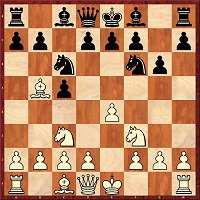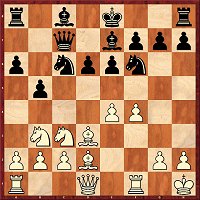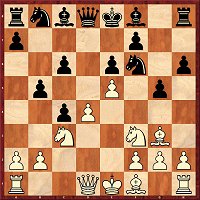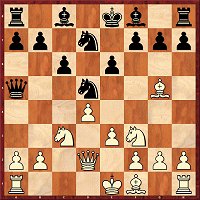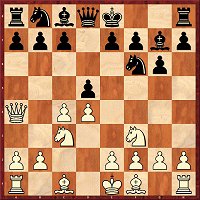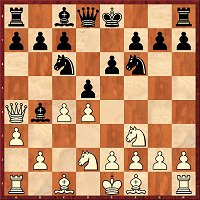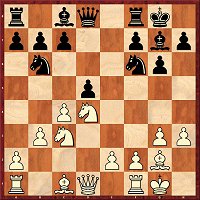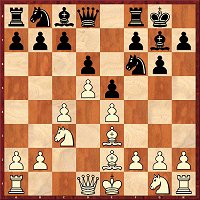|

| Introductory videos
In his introductory video of over a quarter of an hour grandmaster Karsten Müller gives you a survey of the various contents of the DVD and gives you a quick introduction to some of its highlights. For example, the decisive moments from Gelfand’s winning game against Grischuk in the candidates final or Carlsen’s excellent endgame technique in his game against Ivanchuk. In his intro Müller goes into some depth on two openings articles which are on the DVD: on one hand, Breutigam’s investigation of 10.e5 in the Botvinnik Variation and on the other Kuzmin’s theoretically less extensive article on the Queen’s Gambit Declined with 6.Bxf6. |
 | Romanian GM Dorian Rogozenco casts an eye in his 20 minutes videoback over the four tournament highlights of recent months. For example, he introduces in depth Gelfand’s impressive win with Black over Mamedyarov in the first round of their candidates match, at the end of which game Black had on the board six pawns in return for a rook. From the top tournament in Medias Rogozenco presents a fragment from the game of local hero Nisipeanu against Ivanchuk, in which the Romanian managed to break through his opponent’s Berlin Defence. |
| 11.06.-21.06.2011 
Magnus Carlsen
Once again No. 1 in the World
| "Kings Tournament" in Medias Romanian chess organisers are well on their way to establishing this as one of the strongest chess tournaments in the world. The fifth "Kings Tournament" was held for the second time in the small town of Mediasch in the Siebenbürgen area, and the presence of Carlsen, Karjakin, Ivanchuk, Nakamura, Radjabov and Nisipeanu meant there was nothing more one could wish for. Another highlight consisted of the video analyses in which the players participated at the end of their games with head commentator Dorian Rogozenco and which are for the most part accessible on playchess.com. Magnus Carlsen secured victory in the tournament with three wins and seven draws. In the final round a draw with White with Sergey Karjakin, who would also finish on 6.5 points but with an inferior tiebreak score, was sufficient for the Norwegian. |

Carlsen,M - Ivanchuk,V
Position before 65.Nbxd5
| In his game against Vassily Ivanchuk Magnus Carlsen went back to an idea (7.Qc2 in the Queen’s Gambit Declined), which Vladimir Kramnik had made popular in 1993. As Carlsen points out in his analysis, in this variation White cannot hope for a great advantage but does get a slight and persistent one. The game proves how correct his evaluation is. On account of the isolated pawn on the black side, Carlsen kept the upper hand, because Ivanchuk could not find any way to simplify the position by exchanging pieces. After the exchange of queens Carlsen managed to gradually increase the activity of his pieces and in the endgame made copy-book use of the principle of the two weaknesses. In the position on the board on the left the Norwegian brought about the decision by means of 65.Nbxd5. Click on the link under the diagram and play through the game with Carlsen’s own comments. |

Sergey Karjakin
2:0 against Ivanchuk
| A few weeks after his tournament victory on Cuba (see below) Vassily Ivanchuk fared really badly in Mediasch. He became an involuntary supplier of points to the leading players especially and conceded both points to his previous compatriot Sergey Karjakin. Sergey Karjakin has annotated both these wins over Ivanchuk for you on the DVD. InKarjakin,S - Ivanchuk,V we saw a rare guest at the very top level, the Pirc Defence. As Karjakin points out at the start of his analysis, this surprise was not a totally unwelcome one for him. And in fact it was Ivanchuk who left the strait and narrow with 10...e6 and who was already losing after Karjakin’s 12.e5. Click on the link above and see how players at the top level meet the Pirc. |
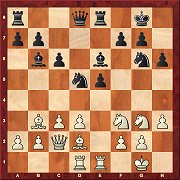
Ivanchuk,V - Karjakin,S
Position after 16.Rad1
| In Ivanchuk,V - Karjakin,S the 21 year old Russian found himself having to fend off the Italian Opening. However it did not prove too difficult a task; he avoided the frequently employed manoeuvre ...a6 and ...Ba7 and achieved full equality after only 13 moves thanks to the early advance 10...d5. The tactical potential of the position obviously escaped Ivanchuk, when in the position on the left he played 16.Rad1. Because it was followed by the surprising strike 16...Bxh3 (the bishop had just moved from c8 to e6); 17.gxh3 is out on account of 17...Qf6 18.Kg2 Nh4+ 19.Nxh4 Qxf2+. As Karjakin shows in his analysis 17.d4 Bg4 18.c4 Rc8! Would have been the lesser evil from White’s point of view, but what happened was 17.c4 Nf4 18.c5 Nxg2 with a clear advantage for Black. |

Nisipeanu,L - Ivanchuk,V
Position before 21.Nf6+
| And Ivanchuk suffered another defeat in Mediasch. In round 3 the Berlin Defence set up by the Ukrainian against Liviu-Dieter Nisipeanu did not hold up. In 11.b3 the Romanian came out with the latest fashionable move in this variation and met Ivanchuk’s over the board innovation 13...c5 with a beautiful and good reply in the form of the knight manoeuvre Nf3-d2-c4-e3-d5. To be sure, the (strong) knight was then immediately exchanged, but then the black position was robbed of the strong trump it had in the bishop pair. In the position on the board, after 20...Rad8 Nisipeanu followed up with a combination (21.Nf6+ Ke7 22.e6 Rxd5 23.Nxd5+ Kd6 24.exf7 Kxd5 25.Re5+), which brought him in an extra pawn. But the game was not yet decided. As Nisipeanu demonstrates in his analysis, both sides missed chances in the time trouble phase, but at the end Ivanchuk resigned in a lost position. |

Liviu-Dieter Nisipeanu
Putting things straight
| All in all, Liviu-Dieter Nisipeanu ought to have been satisfied with his result this year. 4 out of 10 in such a high class field is a strong result. And it could have been more as can be seen from his analysis of the game Radjabov,T - Nisipeanu,L. The Romanian had studied in depth Radjabov’s favourite weapon against the Caro-Kann and courageously played for the initiative. His courage was almost rewarded, but with his thinking time fast running out he chose in a winning final position to go for a draw with perpetual check. Click on the link above and let Nisipeanu show you the game and the tricky win at the end. |
| 05.05.-25.05.2011 
Boris Gelfand
On the road to the title?
| WCh Candidates Matches Kazan It was not white smoke which rose into the sky above Kazan, but somehow everything seemed to have been resolved when the decision was taken. In a war of draws and tiebreaks Boris Gelfand brought all his experience to bear and won the right to appear next year in the WCh title match against Anand. Those who had been considered top favourites, Aronian and Kramnik, looked pretty pale in Kazan and in view of the high number of draws most matches were not decided till the rapid or blitz chess phases. Even the WCh challenger only managed two victories in games with normal tournament thinking time – but that was enough. And these are the two games Gelfand annotates for you on this DVD. |
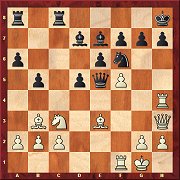
Mamedyarov,S - Gelfand,B
Position after 19...Rfc8
| In the first round Gelfand came up against Shakhriyar Mamedyarov. After two full-length draws at the start, the match was decided this time in game 3, in which the Azerbaijani tried out 6.Bc4 against the Najdorf Variation. At first both sides followed the game Morozevich-Kasparov (2001), but with 15...Kh8 Gelfand avoided the complications from the previous game. The critical position can be found in the diagram on the left after Gelfand’s 19...Rfc8. Here Mamedyarov played 20.Kh1, which Gelfand considers the game-deciding error in view of the subsequent exchange sacrifice 20...Rxc3 21.bxc3 Qxc3 and the clear advantage for Black. In fact, White’s kingside atttack immediately petered out. Play through the game Mamedyarov,S - Gelfand,B with the comments of the Israeli GM and enjoy how with another piece sacrifice Black brought his opponent to his knees with six pawns for a rook. |

Gelfand,B - Grischuk,A
Position before 18.Nh4
| The final game Gelfand,B - Grischuk,A in the final of the candidates matches was, to everyone’s surprise decisive – all previous games in the final had been drawn. Gelfand had changed to 1.d4 and was "100 % sure", that Grischuk would also return to the Grünfeld defence he had employed against Kramnik and Aronian. He was correct and after the innovation 13.b3 Grischuk found himself facing his opponent’s home preparation. The idea behind the move is positional: the black bishop on e6 is hemmed in on both sides by white pawns and thus blocks permanently the advance of Black’s e-pawn. After the opening of the a-file Grischuk transferred his rook via a5 to the h-file, but Gelfand had previously discovered the defensive resource 18.Nh4 (see diagram). After 18...Bf6 19.f4 Black can never get in e7-e5, and after 19...Rd8 20.Qf2 Bxh4 21.gxh4 Gelfand set his powerful centre in motion and won the game in stylish fashion. So, next up is Anand. A lot of people think that he is probably happy with the result of Kazan. "Probably true", said Gelfand in an interview. But before Kazan the Israeli was also an outsider. |

| In his endgame column Karsten Müller presents to you on video a series of tricky endgames from Kazan, including the two Kramnik-Grischuk games in which Black in both cases managed to salvage the draw in an unbelievable way. In addition there is Aronian-Grischuk, in which the co-favourite for the tournament missed victory in the knight ending, and the endgame with rook+bishop against rook+bishop from the game Kramnik-Radjabov, in which there was the now legendary clock defect and interruption to the game. |

Interview with Kramnik
in audio format
| This is an interview with Vladimir Kramnik, conducted by Rainer Knaak and Karsten Müller with the ex world champion only a few days after his elimination. You will find extracts from this interview in audio format on the DVD. In the first part of the interview Kramnik talks, for example, of his endings against Grischuk (games 2 and 4) and of that ending in the blitz game against Radjabov. Kramnik’s explanations on the course of his match with Grischuk and the causes of his failure are especially gripping and enlightening.
In the second part Kramnik goes into the general trend in opening theory. Because of the ever-improving programs the drawing nature of the game of chess is becoming more and more prominent, and it is becoming simpler and simpler to draw with Black. With this in the foreground, Kramnik explains the number of draws in the tournament in Kazan and describes the problems which this had caused him in his preparation for the tournament.
|
| 10.06.-21.06.2011 
Start to finish win for
Ruslan Ponomariov
| Ukrainian Championship Even without Karjakin who had emigrated and the unavailability of Ivanchuk (who was playing at the same time in Mediasch) it was the strongest national championship so far which took place in Kiev in June. Its average Elo rating of 2650 (so category 16) can make many another chess-playing nation jealous. In Ruslan Ponomariov it was the Elo favourite who got to the head of the field right from the start and finished by winning the championship very clearly with 8.5 out of 11. However, his victory as Black against pursuer Moiseenko in the final round was neither without danger nor unnecessary. Because in the endgame he was at some points under extreme pressure and it was not until his opponent under-estimated the potential of Black's passed pawn that Ponomariov was able to turn the tables. At the same time Pavel Eljanov had once more accelerated at the end of the tournament and was on the new champion's heels. So, silver was all there was for Eljanov, and the bronze medal went to Efimenko. |
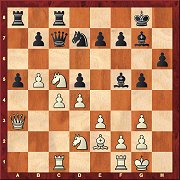
Eljanov,P - Volokitin,A
Position after 22.c4
| Pavel Eljanov has annotated his game against Andrei Volokitin who was not very successful in Kiev. After 1.d4 Nf6 2.Nf3 g6 Ejlanov played 3.Bg5 and obliged his opponent to invest three quarters of an hour in the first five moves. That had its effect. In position in the diagram Eljanov put Black’s position under pressure, first with 22.c4 and after 22.dxc4 with 23.g4!. As Eljanov explains in his analysis, his opponent now made the decisive mistake with 23...Nxc5, because White is clearly winning after 24.gxf5 Qd8 25.Bxc4 Nd7 26.Qa2 Qe8 27.Bd5, and the knight which was transferred to the queenside finally decided the day. |
| 15.05.-21.05.2011 
Alexei Shirov
Victory with new weapons
| Lublin With 5 out of 7 Alexei Shirov won the third GM tournament in Lublin. The Spaniard from Latvia won three games and drew the remainder. The opening weapons with which Shirov confronted his opponents are remarkable (King’s Gambit with White, French with Black. On the DVD he presents and explains them in five videos with a total playing time of more than two hours! The places behind Shirov were occupied by Boris Grachev and Sergej Zhigalko. On the DVD you will also find game analysis by Krishnan Sasikiran and Michael Roiz. |

Wojtaszek - Shirov
Position after 30...Rg8
Video analysis
| After his disastrous result in Wijk aan Zee Alexei Shirov had prescribed for himself several months of rest from tournament play. As he points out at the start of his video, it was with mixed feelings that he travelled to the strong category 18 tournament in Lublin. As well, he had to meet in the very first round (with Black) the Elo favourite Radoslaw Wojtaszek. Despite the recent negative experiences which Shirov had been having with “his” Semi-Slav, he kept faith in his opening against the Polish player. In a video analysis of this game lasting almost three quarters of an hour, Shirov explains, for example, why after the rare move 9.a3 he did not go in for the drawish variation with 9...a6. Shirov is happiest of all with his 22...g5, which finally directed the game into highly tactical lines. In the position in the diagram after 30...Rg8 the logical looking 31.Rd6 would have failed after 31...Rxg2+ 32.Kf1 b2!. In the game things went 31.g3 b2 32.Rb1 Qb3 33.Nd6 Ba6. and not much later the white position collapsed. |

Zhigalko - Shirov
| After a second round draw with White against Roiz, Shirov followed up with his second surprise as Black against Zhigalko. After recently always meeting 1.e4 with 1...e5, he once again tried out the French against the Belorussian. In his video analysis Shirov starts by discussing at length his preparation and the historical development of the variation with 11.Qf2 which had been introduced by Kramnik in 2003 and even introduces what he considers to be the present critical variation for Black. In the game Shirov got a crushing attack on the king, but then in a won position he played a dubious rook sacrifice and finally won the game nevertheless because his opponent could not find the correct defence. An absolute must-see for French fans! |
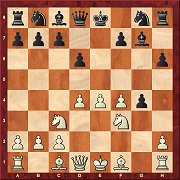
Shirov - Alekseev
Position before 8.Rg1
Video analysis
| The King’s Gambit! In the following round too Shirov surprised (or shocked?) his opponent. How did he come to test out what he had referred to in his own words an “incorrect opening”? In the third video analysishe tells us the whole story which had its origins in a training seminar for up-and-coming DSB players back in April. In the game Alekseev chose the 3...h6 variation. A dubious move, in Shirov’s opinion, and he was able to refute it in the game. After 8.Rg1 (diagram) White already has a clear advantage and after 8...Kf8 9.Be3 Nc6 10.d5 Nb4 Shirov could have won the game in quite unspectacular fashion with 11.Nd4 Qh4+ 12.Bf2 Qxh2 13.Nce2 followed by the advance of the e-pawn. The decision came in time trouble, when Shirov first lost the thread and overlooked tactical options for his opponent, but in the long run Alekseev resigned, because he - like Shirov – wrongly thought that the black king was in a mating net. |

Sasikiran - Shirov
| The final two games were less successful for Shirov, and above all in Sasikiran-Shirov the Spaniard was on the brink of defeat. In his analysis of this game he is particularly hard in his judgement about his own preparation – once again we had a Semi-Slav. His plan of sacrificing a pawn for the initiative and quickly recovering the pawn with equality did not work. Instead, Shirov even lost a second pawn and had to struggle for a draw right into the bishop ending. |
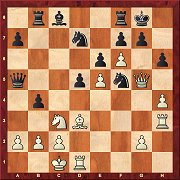
Shirov-Grachev
Position before 18.Bxf5
Video analysis
| Before the final round Shirov was leading the table by half a point, and although a draw would have sufficed, he of course played for a win with White against Boris Grachev. In the French Defence Shirov would have liked to have repeated the variation with which he had been successful against Zhigalko (with Black!), but his opponent deviated earlier with 10...Bxd4 and put Shirov’s theoretical knowledge to the test. After the dubious 12.h4 and the reply 12...Rb8 he was obliged to realise, that the white position was rather disadvantageous from a strategic point of view and decided to guide the game into tactical channels with 13.Rh3. After Grachev’s 15...b4 the board was on fire, and after 16.Qg5 Nf5 17.Bd3 h6 Shirov sacrificed his queen with 18.Bxf5 (diagram). Next came 18...hxg5 19.hxg5 bxc3 and after 20.Bh7+ White had no more but no less than a perpetual check. That was how Alexei Shirov secured tournament victory, with an entertaining game although it ended in a draw. |

Krishnan Sasikiran
analyses
| Indian GM Krishnan Sasikiran annotates on the DVD both of his wins from Lublin. In Wojtaszek,R - Sasikiran,K he set about things enthusiastically in a Nimzo-Indian and profited from the fact that his opponent was too ambitious with his continuation 23.g4, thus exposing his king to a decisive counter by the Indian. In the game Sasikiran,K - Alekseev,E the protagonists followed the paths of Catalan theory for a long time, till the Indian played the innovation 20.Qh5, of which both sides were obviously well aware. Sasikiran has provided the game with very detailed analysis and shows you the move with which his opponent gave the game away just before the time control.
|
| 11.05.-21.05.2011 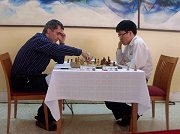
Ivanchuk - Le Quang
Finished equal on points
| Capablanca Memorial Havana It was thanks to a brilliant final spurt and at the very last second that Vassily Ivanchuk once again defended his title in the Capablanca Memorial on Cuba. Le Quang Liem had taken the lead in the second flight of games and it was not till their duel in the final round that the experienced player managed to catch up the Vietnamese GM and win the tournament thanks to a better tiebreak score. You will find all the games from Havana on the DVD, Le Quang has annotated for you not only his win over Bruzon, but also the decisive game against Ivanchuk. |
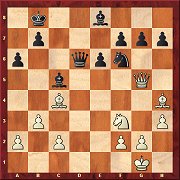
Ivanchuk,V - Le Quang,L
Position after 22.Qg5
| Le Quang wanted to surprise his experienced opponent with his choice of the French Defence. Simply, Ivanchuk was not in the least put out. The game followed well-known paths in the Tarrasch Defence, though the Vietnamese player came out of the opening with a slight disadvantage thanks to an inaccuracy (12...Bd7, see the analyses by Le Quang). But after a general exchange of rooks Black’s problems seemed to have been put behind him. In the position on the board there followed 22...Ne4 23.Qxg7 Qd1+ 24.Kh2 and now 24...Nxf2 e.g. would have led to an exchange of queens and a drawish endgame after 25.Qe5 Bd6 26.Qxd6 Qxd6 27.Bg3. It was Le Quang’s misfortune to twice scorn the saving knight strike on f2 and he was finally defeated in ice-cool fashion by the Ukrainian. |
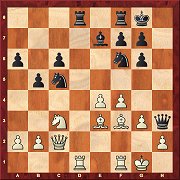
Le Quang,L - Bruzon Batista,L
Position after 22.Qh3
| In Le Quang,L - Bruzon Batista,L the young Vietnamese player showed his positional ability and far-sightedness. In the Slav he choose a quiet setup (e.g. with 10.g3) and managed to come out of the opening slightly ahead. In the position on the board on the left his opponent allowed himself to be tempted into 22.Qc8-h3. It was a mistake, as Le Quang points out in his analysis. Because after 23.Qf2 Ne6 White can force with 24.Qg2 the exchange of queens and with that the transition to an advantageous endgame. In the game Le Quang demonstrated the weakness of Black’s queenside and his own superior piece play. Play through the game with his comments and on no account miss the concluding mating attack. |
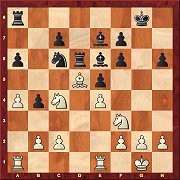
Negi,P - Caruana,F
Position before 16...Rxd5
| Fabiano Caruana annotates At India's strongest chess tournament of all time, the "Airports Authority of India International Grandmasters Chess Tournament 2011" in New Delhi it was Fabiano Caruana who won with one point of a lead. An impressive victory in a category 17 tournament, to which only young and ambitious players were invited. Things were hard for Yifan Hou. The women's world champion had to submit to five defeats and ended up in last place. On the DVD Caruana annotates his impressive victory with Black over Parimarjan Negi. In the opening he deliberately steered towards a positional exchange sacrifice (see diagram before 16...Rxd5 17.exd5 Bxd5 18.Ne3 Be6), from which he was hoping to get sufficient initiative. In fact in the middlegame he kept on developing more active piece play and finally demolished the white position in remarkable style. |
| | |
|

Bindrich - Firman
With which move does White extend his advantage? You will find the answer in the Strategy column by Peter Wells.
| From the opening trap to the endgame study
Training in ChessBase Magazine begins with the very first moves and deals with every phase of a game of chess. You will find the very latest Openings articles with their many ideas and suggestions for your repertoire alsoabove among the links. Rainer Knaak’s opening trap (including a Fritztrainer video) deals this time with a trap from the Dutch (A83). Also to be found in video format are opening contributions from Leonid Kritz (French Winawer Variation), Martin Breutigam (Slav Exchange Variation), Valeri Lilov (Sicilian Grand Prix Attack) and Adrian Mikhalchishin (King’s Indian). You will find these videos in the Fritztrainer column. Peter Wells’ subject in his Strategy Column is: “The essential art of exchanging queens”, see the diagram on the left. In Daniel King’s long running Move by Move it is a game in the French which is being used this time. And in the Tactics (subject: mate, mate, mate!) and Endgame columns (subject: bishops of opposite colours) Oliver Reeh and Karsten Müller have once more brought together for you the best from recent tournament practice. |
































